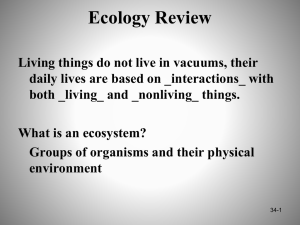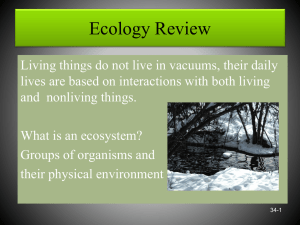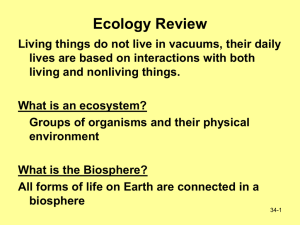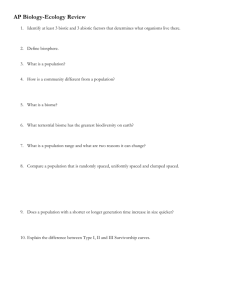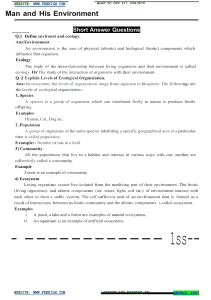Ecology PPT OL NAME______________________
advertisement
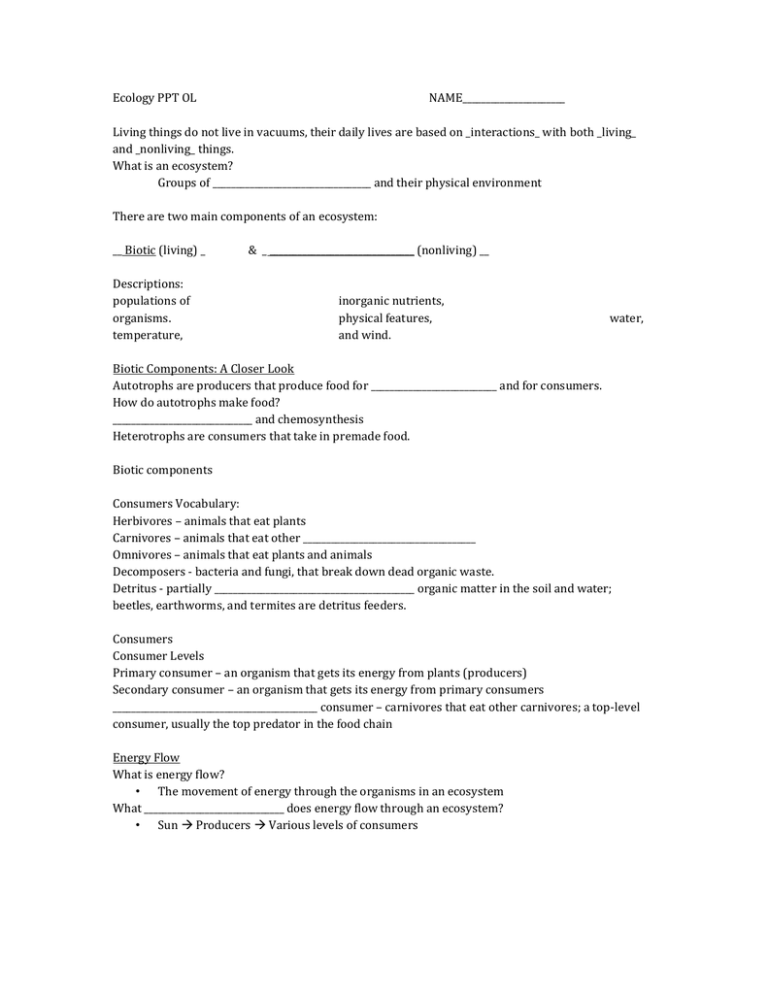
Ecology PPT OL NAME______________________ Living things do not live in vacuums, their daily lives are based on _interactions_ with both _living_ and _nonliving_ things. What is an ecosystem? Groups of __________________________________ and their physical environment There are two main components of an ecosystem: __ Biotic (living) _ Descriptions: populations of organisms. temperature, & _ _______________________________ (nonliving) __ inorganic nutrients, physical features, and wind. water, Biotic Components: A Closer Look Autotrophs are producers that produce food for ___________________________ and for consumers. How do autotrophs make food? ______________________________ and chemosynthesis Heterotrophs are consumers that take in premade food. Biotic components Consumers Vocabulary: Herbivores – animals that eat plants Carnivores – animals that eat other _____________________________________ Omnivores – animals that eat plants and animals Decomposers - bacteria and fungi, that break down dead organic waste. Detritus - partially ___________________________________________ organic matter in the soil and water; beetles, earthworms, and termites are detritus feeders. Consumers Consumer Levels Primary consumer – an organism that gets its energy from plants (producers) Secondary consumer – an organism that gets its energy from primary consumers ____________________________________________ consumer – carnivores that eat other carnivores; a top-level consumer, usually the top predator in the food chain Energy Flow What is energy flow? • The movement of energy through the organisms in an ecosystem What ______________________________ does energy flow through an ecosystem? • Sun Producers Various levels of consumers Energy Flow • As energy flows from _autotrophs_ (producers) to _heterotrophs_ (consumers) much of the energy is lost before the consumer can use it. • In what forms is energy lost? Heat • Initial energy from an ecosystem comes from a consistent supply of ____________________ energy **Remember energy in an ecosystem may be transferred or converted but will not be created nor destroyed** Energy balances Nature of an ecosystem Food chains vs. food webs What is a food chain? A diagram that links organisms together by who eats whom • Starts with _plant life_ and ends with an _animal_. • Most food chains have no more than _4 or 5_ links • Arrows show the direction __________________________________ is flowing_ • EXAMPLE: grass zebra lion Food chain FOOD WEB Most consumers feed on and are eaten by _more than one_ other _______________________________ What is a food web? • A combination of several food chains showing all of the possible energy pathways • What is a trophic level? All of the organisms that feed at a particular link of the food chain/web Grazing food web – The upper portion of a food web based on a living plant as the _________________________________ Detrital food web – The lower portion of a food web based on detritus Forest food webs Ecological Pyramids Why are food chains so short? Only about 10% of energy is useable from one trophic level to the next • The number organisms drastically _______________________________ as you go up in level of a food chain What is an ecological pyramid? A series of blocks representing the biomass of particular organisms on a particular trophic level What is biomass? The amount of living material in the population of an organism Ecological pyramid Biochemical cycles What are biochemical cycles? • The path by which important nutrients/molecules travel through an ecosystem. 3 Important Cycles: • Water Cycle • __________________________ Cycle • Nitrogen Cycle The Water Cycle Water movement: Land Atmosphere: • Liquid Gas • ______________________________________ from rivers, lakes and oceans • Transpiration from plants Atmosphere Land • Gas Liquid • Precipitation over land and bodies of water • Runoff forms bodies of water (lakes, rivers, oceans) • Ground water seepage into aquifers The water cycle The Carbon Cycle Carbon Movement: Land/Water Atmosphere • Respiration • Combustion Atmosphere Land/Water • _______________________________________ • Dissolved CO2 ** Carbon is stored as _fossil fuels__ from decaying organisms.** The carbon cycle The Nitrogen Cycle Nitrogen Movement: • Nitrogen Fixation _______________________________________________ found in legume roots converts N2 gas into _Ammonia (NH4)_ • _Decomposers_ break down waste and organic remains into _Ammonia (NH 4)_ • Nitrification bacteria convert ammonia into _Nitrite (NO2)_ and _Nitrate (NO3)_ to be used by _plants_ • Denitrification Bacteria converts _ammonia_ back into _Nitrogen gas (N2) The nitrogen cycle
